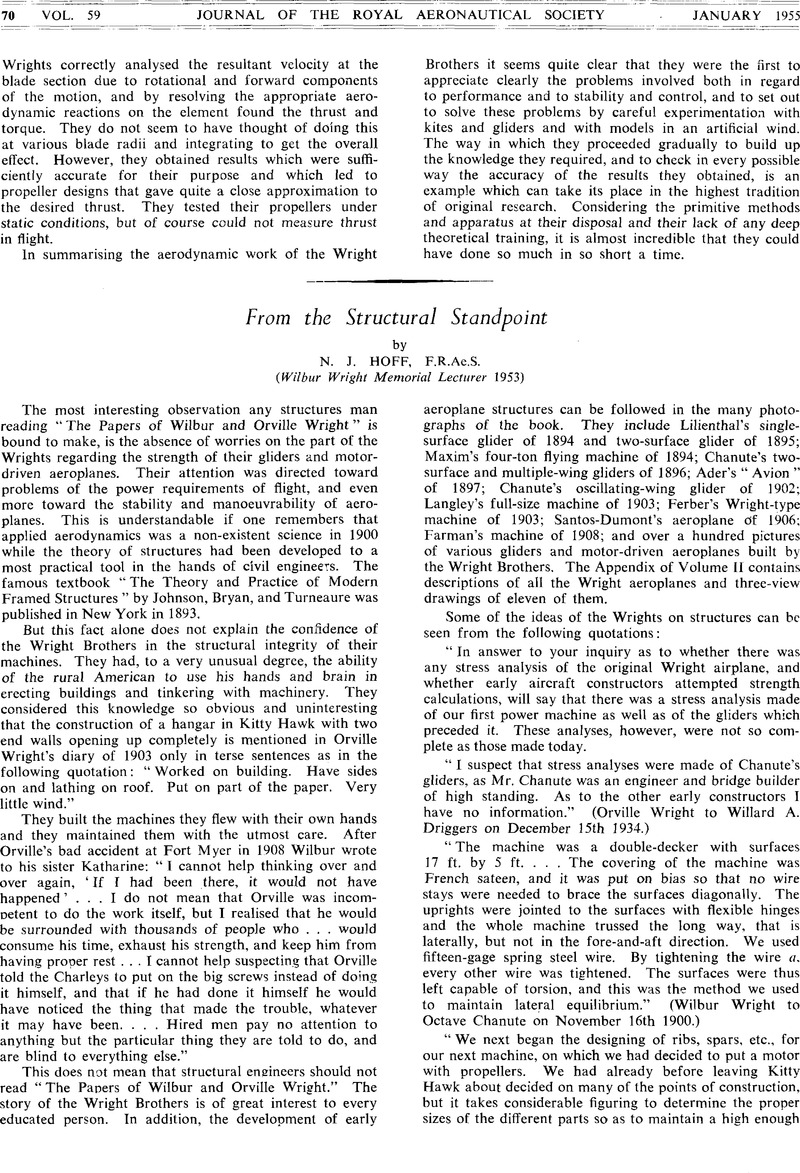No CrossRef data available.
Article contents
From the Structural Standpoint. N. J. Hoff, F.R.Ae.S., Wilbur Wright Memorial Lecturer 1953
Published online by Cambridge University Press: 28 July 2016
Abstract

- Type
- The Library
- Information
- Copyright
- Copyright © Royal Aeronautical Society 1955
References
Note on page 71 * In his Wilbur Wright Memorial Paper, delivered on 14th September 1953 (January 1954 Journal), Professor Hoff quoted from a letter written by Orville Wright to T. R. C. Wilson. This letter is not given in the two volumes under review, but is of such significance that it is reprinted here as a footnote, together with Professor Hoff's comments and quotation from a letter from Wilbur Wright to his father, and the entry in Orville Wright's diary for 16th November 1900, both of which appear in these volumes.—ED.
“The Wrights were most careful in selecting and testing the materials of construction and considered dynamic tests as imoortant as static tests. On 6th September 1917 Orville Wright wrote to Thomas R. C. Wilson:
’In 1901, 1902, and 1903 we made a number of tests upon Eastern spruce and white pine. The spruces when kiln dried by the processes of that day were very inferior to the air–dried. The white pine did not seem to suffer so much in the dry kiln. The shock tests indicated that the spruce was superior to clear white pine. But the superiority of the spruce was more apparent in practical use in the machines.'
“The shock test is described in a letter Orville Wright wrote to F. O. Clements on 17th July 1917:’ I am giving below the results of the tests made on the several pieces of lumber which you sent me.
’The pieces tested were 1/4 in. square. A blow with a 21 1/2 lb. wooden hammer was applied midway between the supports which were 20 in. apart.'
”On 23rd September 1900 Wilbur Wright tried to convince his father, the Reverend Milton Wright, that he was taking the necessary precautions to ensure that their glider was safe structurally:
’I am constructing my machine to sustain about five times my weight (700 lb. plus?) and am testing every piece.' ” Regarding the strength tests of the complete aeroplane one may refer to an entry in Orville Wright's diary made on 16th November 1903:
’We hung the machine on tips to test strength. The cloth wrinkled badly, necessitating a change in the trussing of the tips so that the strain be more evenly carried by front and rear spars and uprights. This requires a change in the controlling wires which will have to be operated at the rear. The uprights stood test of twice what will be required of them even though the wire connecting their centers had not been put in yet.'
“An entry on 17th November 1903, reads:
’Worked today on changing wires and in putting on wire to connect centers of front uprights. Supported at tips machine stood test of 440 lbs. at center without any signs of being overburdened.'“




